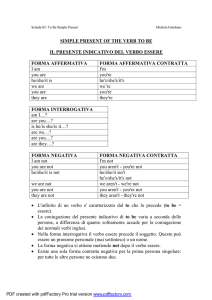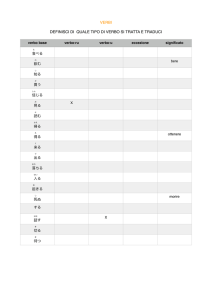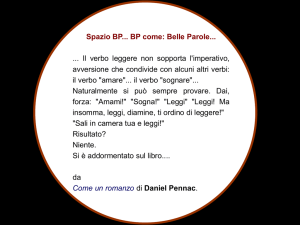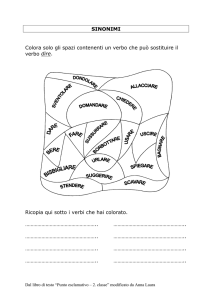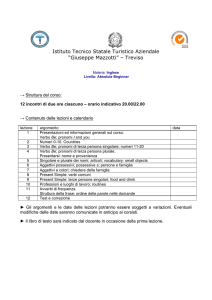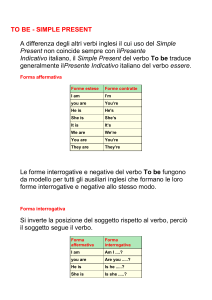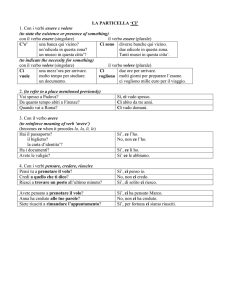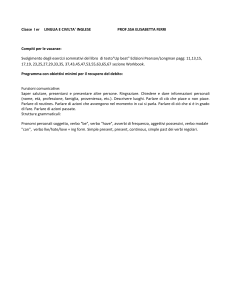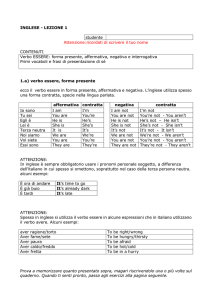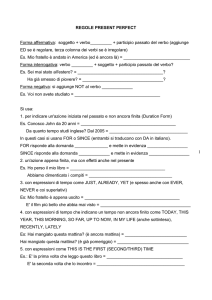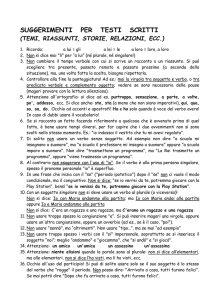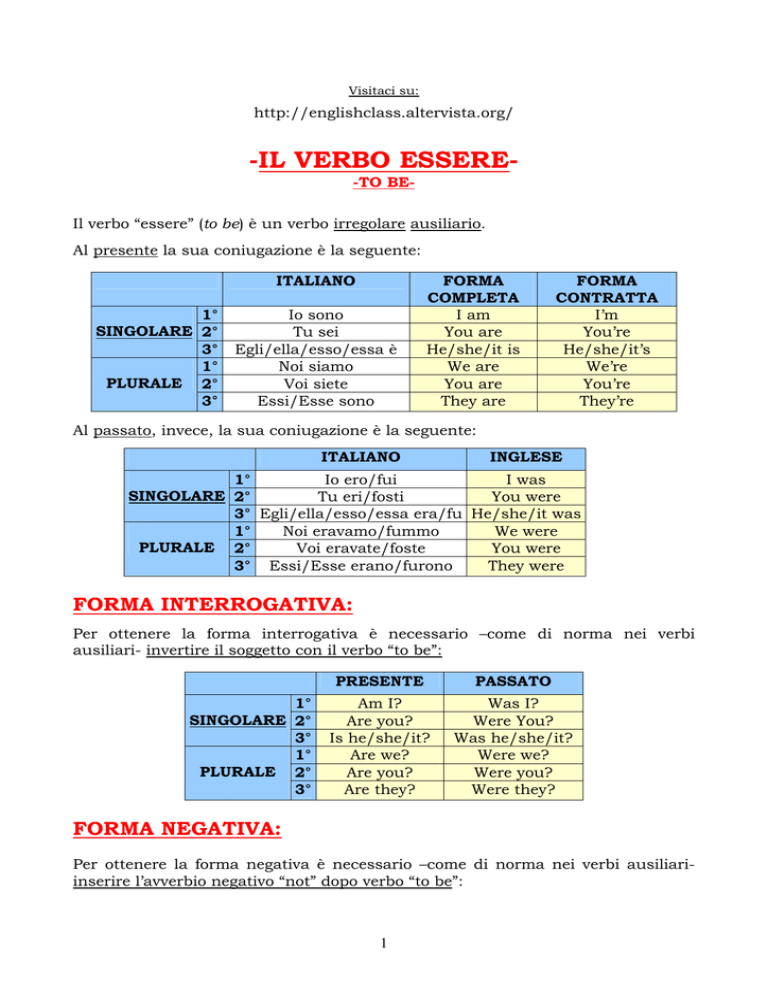
Visitaci su:
http://englishclass.altervista.org/
-IL VERBO ESSERE-TO BEIl verbo “essere” (to be) è un verbo irregolare ausiliario.
Al presente la sua coniugazione è la seguente:
ITALIANO
1°
SINGOLARE 2°
3°
1°
PLURALE 2°
3°
Io sono
Tu sei
Egli/ella/esso/essa è
Noi siamo
Voi siete
Essi/Esse sono
FORMA
COMPLETA
I am
You are
He/she/it is
We are
You are
They are
FORMA
CONTRATTA
I’m
You’re
He/she/it’s
We’re
You’re
They’re
Al passato, invece, la sua coniugazione è la seguente:
ITALIANO
INGLESE
1°
Io ero/fui
I was
SINGOLARE 2°
Tu eri/fosti
You were
3° Egli/ella/esso/essa era/fu He/she/it was
1°
Noi eravamo/fummo
We were
PLURALE 2°
Voi eravate/foste
You were
3° Essi/Esse erano/furono
They were
FORMA INTERROGATIVA:
Per ottenere la forma interrogativa è necessario –come di norma nei verbi
ausiliari- invertire il soggetto con il verbo “to be”:
1°
SINGOLARE 2°
3°
1°
PLURALE 2°
3°
PRESENTE
PASSATO
Am I?
Are you?
Is he/she/it?
Are we?
Are you?
Are they?
Was I?
Were You?
Was he/she/it?
Were we?
Were you?
Were they?
FORMA NEGATIVA:
Per ottenere la forma negativa è necessario –come di norma nei verbi ausiliariinserire l’avverbio negativo “not” dopo verbo “to be”:
1
PRESENTE
1°
SINGOLARE 2°
3°
1°
PLURALE 2°
3°
FORMA NON CONTRATTA
FORMA CONTRATTA
I am not
You are not
He/she/it is not
We are not
You are not
They are not
I’m not
You’re not/You arent’t
He/she/it’s not – He/she/it isn’t
We’re not/We aren’t
You’re not/You aren’t
They’re not/They aren’y
PASSATO
1°
SINGOLARE 2°
3°
1°
PLURALE 2°
3°
FORMA NON CONTRATTA
FORMA CONTRATTA
I was not
You were not
He/she/it was not
We were not
You were not
They were not
I wasn’t
You weren’t
He/she/it wasn’t
We werent’t
You weren’t
They weren’t
FORMA INTERROGATIVA-NEGATIVA:
Per ottenere la forma interrogativa-negativa è necessario sia invertire il soggetto
con il verbo sia inserire l’avverbio negativo “not”:
PRESENTE
1°
SINGOLARE 2°
3°
1°
PLURALE 2°
3°
FORMA NON CONTRATTA
FORMA CONTRATTA
Am I not?
Are you not?
Is he/she/it not?
Are we are not?
Are you not?
Are they not?
Aren’t I?
Aren’t you?
Isn’t he/she/it?
Aren’t we?
Aren’t you?
Aren’t they?
PASSATO
1°
SINGOLARE 2°
3°
1°
PLURALE 2°
3°
FORMA NON CONTRATTA
FORMA CONTRATTA
Was I not?
Were you not?
Was he/she/it not?
Were we are not?
Were you not?
Were they not?
Wasn’t I
Weren’t you?
Wasn’t he/she/it?
Weren’t we are?
Weren’t you?
Weren’t they?
LE FORME CONTRATTE:
Le forme contratte sono utilizzate nel linguaggio parlato e nello scritto informale,
in quanto più veloci.
2
Le forme contratte affermative non si usano mai, però, al termine di una frase.
Vuoi sapere chi sono?→ You wanna know who I am?
Nelle frasi interrogative negative è invece utilizzata quasi esclusivamente la forma
contratta.
P.S.
Esiste anche una particolare forma di contrazione utilizzata solo nel linguaggio
gergale e molto comunemente nelle canzoni. Normalmente viene considerata una
forma un po’ rozza, da evitarsi in un linguaggio più elegante.
Si tratta di “Ain’t”.
“Ain’t” sta per “am not”, “aren’t”, “isn’t”, ed è utilizzato sia nelle frasi negative che
nelle interrogative negative.
PARADIGMA:
Il paradigma di un verbo è caratterizzato da:
Infinito – past tense – past participle
Il paradigma del verbo “to be” è dunque:
to be – was/were - been
USI DEL VERBO :
In generale, l’uso che l’inglese fa del verbo “to be” è esattamente quello che
l’italiano fa del verbo “essere”.
Esistono però delle eccezioni: vale a dire che molto spesso la lingua inglese
utilizza il verbo “to be” anche in altri contesti, che non hanno il loro corrispettivo
nella lingua italiana. Vediamoli.
Il verbo “to be” significa “essere”, “trovarsi”.
Molto spesso, con l’accezione di “trovarsi in un determinato posto” in italiano si
utilizza il verbo “stare”. In inglese “stare” si traduce ancora una volta con il verbo
“to be”.
Sto qui → I’m here
Stiamo insieme da Natale → We have been together since last Christmas
In alcuni casi si può utilizzare con questa accezione anche il verbo “to stand”, ma
è più raro.
Il verbo “to be” è utilizzato con il significato di “essere/trovarsi” anche per quanto
riguarda la salute o lo stato d’animo.
Come stai? Sto bene → How are you? I’m fine.
3
E’ da non confondere “stare” nel senso di “trovarsi, essere” con “stare” nel senso
di “restare o rimanere”: in questo secondo caso si utilizza in inglese il verbo “to
stay”.
Resta con me → Stay with me
A volte il verbo “essere” viene sostituito in italiano dal verbo “fare, comportarsi”.
Non è così in inglese.
Non essere stupido/non fare lo stupido → Don’t be stupid!
Contrariamente all’italiano, in cui si utilizza il verbo “avere”, in inglese il verbo “to
be” è utilizzato anche per chiedere/dire l’età.
Quanti anni hai? Ho nove anni. → How old are you? I’m nine.
Il verbo “essere” è utilizzato in inglese anche in alcune frasi relative alla
condizione fisica o mentale, nella quali in italiano si utilizza invece ancora una
volta il verbo avere.
To
To
To
To
To
To
be
be
be
be
be
be
hungry/thirsty → Avere fame/sete (letteralmente: essere affamato/assetato)
cold/hot → Avere freddo/caldo
right/wrong → Avere ragione/torto
afraid → Avere paura
ashamed → Avere vergogna, vergognarsi
sorry → Essere dispiaciuti, dispiacersi
...E molte altre ancora.
Nell’esprimere il prezzo, la distanza o le misure.
Quanto costa? → How much is it? (“How much does it cost” non è utilizzato)
La stazione dista poco dal villaggio → The train station is not far from the village
L’area misura pochi metri → The area is few metres large
Visitaci su:
http://englishclass.altervista.org
4

